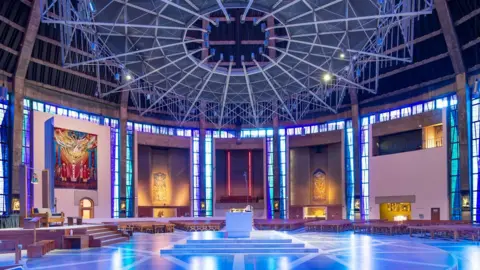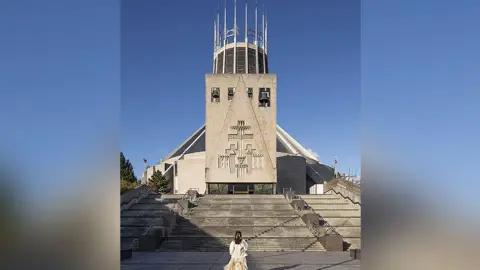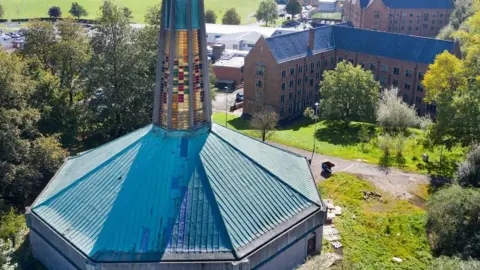'Revolutionary' cathedral's listed status upgraded
 Historic England
Historic England"A true jewel in Liverpool's crown" has had its listed status upgraded to recognise the building's "architectural brilliance".
The Metropolitan Cathedral, affectionately known as a "wigwam" due to its unique shape, has been awarded Grade I-listed status by the government.
Sir Frederick Gibberd's design was considered revolutionary when the cathedral was built in the 1960s and "transformed" Catholic worship spaces, Historic England (HE) said.
Meanwhile another building designed by Sir Frederick - Hopwood Hall Chapel in Rochdale, Greater Manchester - has also been updated to recognise the features it shares with the Metropolitan Cathedral, such as a lantern tower of coloured glass.
 Historic England
Historic EnglandLiverpool's Catholic cathedral, built between 1962 and 1967, sits at the opposite end of Hope Street to its Anglican counterpart.
Archbishop of Liverpool John Sherrington welcomed the landmark building's upgrade from Grade II*-listed.
He said the cathedral had been described as "the soul of the city", adding that it brought hope to thousands of visitors each year.
HE spokesperson Sarah Charlesworth said the cathedral "transformed British cathedral design with its revolutionary centralised plan, representing a radical departure from traditional designs".
Liverpool Riverside MP Kim Johnson said the Metropolitan Cathedral was an "instantly recognisable symbol" of the city.
She added the recognition "rightly honours its architectural significance and the prominent place it holds in our skyline – a true jewel in Liverpool's crown".
Liverpool City Region mayor Steve Rotheram said: "Liverpool is a city with a proud architectural and cultural heritage, and the Metropolitan Cathedral is one of its most iconic landmarks.
"The bold, modern design broke new ground and has become a beacon of faith, hope and innovation, not just for our region but across the world."
 Historic England
Historic EnglandThe cathedral was built over a crypt, designed by Sir Edwin Lutyens, which was intended to be part of a grand classical-style building that began in the 1930s.
Construction was halted due to financial constraints and the outbreak of World War Two.
Catherine Croft, director of The Twentieth Century Society, a charity which campaigns to save modern architectural and design heritage, said the cathedral was "unique in world architecture and has long been a powerful homecoming beacon for Liverpudlians".
She said Liverpool "now rightly has two magnificent Grade I-listed cathedrals".
The existing Grade II listing for Hopwood Hall Chapel, which was built in 1964 according to Sir Frederick's designs, was overseen by Reynolds and Scott.
The listing for the former chapel at Hopwood Hall College on Rochdale Road, Middleton, has been updated to recognise the "shared architectural significance" with the Metropolitan Cathedral.
Listen to the best of BBC Radio Merseyside on Sounds and follow BBC Merseyside on Facebook, X, and Instagram. You can also send story ideas via Whatsapp to 0808 100 2230.
